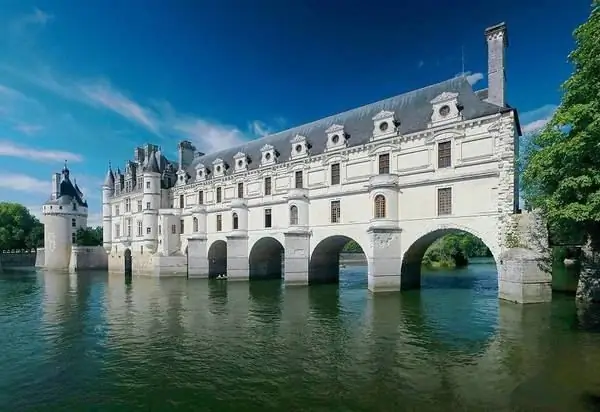
Description of the attraction
Chenonceau Castle, or, as it is sometimes called, "ladies' castle" - one of the most beautiful and romantic in the Loire Valley. It crosses the Cher River like a bridge - it seems to grow straight out of these slow waters. An amazing sight.
The history of the castle dates back to the 13th century. From 1243 it belonged to the de Marc family. During the Hundred Years War, the French owner placed an English garrison in the fortress. The enraged king ordered to tear down the fortifications, the family had to sell the inheritance to the financial quartermaster of Normandy Thomas Boyer. He demolished the old castle (except for the keep) and erected a new one.
Already at the construction stage, the fate of the castle was determined: in the absence of Boyer, his wife Catherine supervised the work. Corner towers on four sides surrounded the central volume with pointed vaults. The beauty of the castle did not benefit the family: in 1533, Francis I confiscated the property - officially for the financial sins of Thomas Boye, in fact, wanting to get excellent hunting grounds. The king was having fun here in a narrow circle, which included his second wife Eleanor of Habsburg, son Henry, daughter-in-law Catherine de Medici, favorite of the monarch Anne de Pisleux and mistress of his son Diane de Poitiers.
In 1547, the crown passed to Henry II, and he, in violation of the law, presented the castle to Diane de Poitiers. She redesigned the park and garden, planted artichokes and melons. It was Diane de Poitiers who undertook the construction of a stone bridge over the Cher River.
In 1559, Henry II died of a wound received in the tournament, Catherine de 'Medici became regent and regained Chenonceau. She arranged brilliant holidays here, laid out new gardens. In 1580, the architect Andrue Dyceseau built a new wing of the castle on a stone bridge with rhythmically alternating projections (protrusions on the facade). The castle has acquired a modern look. Dying, the Medici handed him over to Louise de Vaudemont, wife of Henry III. She wore white mourning for the king here, which is why the widow de Vaudemont was nicknamed "the white lady."
In 1733, the castle passed into the hands of the banker Claude Dupin. His wife Louise opened a fashionable salon here, set up a theater and a physical office. Madame Dupin lived in Chenonceau until she was ninety-three years old, surrounded by loving servants who kept the estate intact during the revolution.
Since 1888, Chenonceau has belonged to the wealthy Meunier family. During the First World War, Senator Gaston Meunier placed a hospital here for two thousand front-line soldiers. During World War II, the castle, located on the border of the territory of France unoccupied by the Nazis, became a contact point for the Resistance.
Today, visitors walk to the castle along a long alley lined with old plane trees. On the right is the garden of Diane de Poitiers, at the entrance to it is the Chancellery, the house of the manager of the 16th century. An ancient donjon stands in the corner of the Main Courtyard. On the lower floor of the castle there is the Hall of the Guards with tapestries from the 16th century. In the art gallery there are paintings by Rubens, Primaticcio, Van Loo, Mignard, Nattier. The former royal stables houses a wax museum. It recreates scenes of love and jealousy that were played out here hundreds of years ago.
On a note
- Location: Château, Chenonceaux
- Official website:
- Opening hours: open daily, during low season 9.30-17.00; in the summer 9.00-19.30. Ticket offices stop working half an hour before closing.
- Tickets: adults - 12, 5 euros, children from 7 to 18 years old - 9, 5 euros, children under 7 years old - free.






